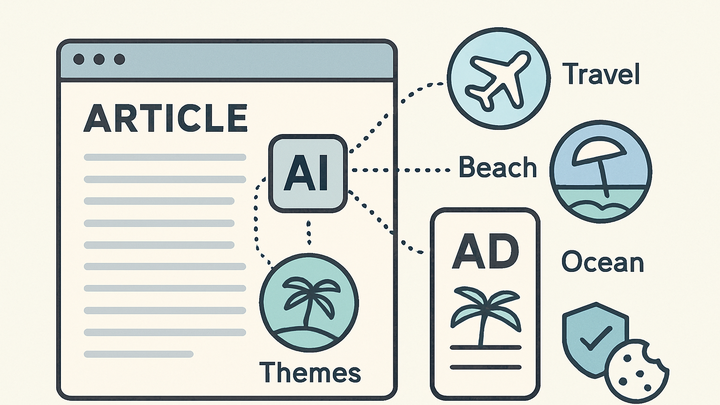Published on 2025-06-22T07:11:02Z
What is Contextual Targeting? Examples and Use Cases
Contextual targeting is a digital advertising technique that places ads based on the content of the web page rather than the user’s past behavior. It uses automated analysis—like keyword detection and semantic understanding—to determine the theme of a page in real time. This approach avoids tracking individual user data, offering a privacy-friendly alternative to behavior-based methods. In the analytics industry, contextual targeting integrates with platforms like PlainSignal and Google Analytics 4 (GA4) to capture and act on contextual signals without relying on cookies. PlainSignal, for example, provides cookie-free page context metrics that can feed into ad decision-making processes. GA4 supports custom event and parameter tracking for contextual variables, enabling marketers to align ad campaigns with page topics. By focusing on what the user is currently viewing, contextual targeting delivers relevant ads while respecting user privacy and regulatory requirements.
Contextual targeting
Contextual targeting places ads based on webpage content analysis, ensuring relevance and privacy compliance without cookies.
How Contextual Targeting Works
Contextual targeting relies on analyzing page content to determine themes and then matching relevant ads in real time. It avoids tracking individual user history, focusing solely on what the user is viewing at that moment.
-
Content analysis
Leveraging machine learning and natural language processing to scan page text, images, and metadata to extract topics and sentiment.
-
Keyword matching
Identifies specific keywords to categorize the page content into relevant buckets.
-
Semantic analysis
Goes beyond keywords to understand the broader context, tone, and intent of the content.
-
-
Contextual matching
Selecting ad creatives that align with the identified themes to ensure relevance and increase engagement.
-
Real-time ad delivery
Serving ads in milliseconds by integrating with ad servers or programmatic platforms to automatically insert relevant ads.
Benefits of Contextual Targeting
By focusing on content rather than user history, contextual targeting offers privacy compliance, improved engagement, and brand safety.
-
Privacy compliance
Does not rely on cookies or personal data, making it GDPR and CCPA friendly.
-
Cookie-free approach
Eliminates the need for user tracking, reducing regulatory complexity.
-
-
Improved relevance
Ads are closely aligned with the user’s current interests based on page content.
-
Brand safety
Minimizes the risk of ad placement on inappropriate or risky content by pre-defining safe content categories.
Implementing Contextual Targeting with Analytics Platforms
Analytics platforms can help track contextual metrics and integrate with ad systems to automate targeted campaigns. Below are two approaches using popular tools.
-
PlainSignal (cookie-free analytics)
PlainSignal provides simple, privacy-first metrics. Use it to capture page context without cookies by adding the following code to your site:
-
Code example
<link rel="preconnect" href="//eu.plainsignal.com/" crossorigin /> <script defer data-do="yourwebsitedomain.com" data-id="0GQV1xmtzQQ" data-api="//eu.plainsignal.com" src="//cdn.plainsignal.com/plainsignal-min.js"></script>
-
-
Google analytics 4 (GA4)
GA4 supports custom event tracking for contextual data. Define parameters like page_topic or content_category to pass context to your analytics.
-
Setting up contextual events
gtag('event', 'page_context', { page_topic: 'technology', content_category: 'blog' });
-
Best Practices and Considerations
To maximize the effectiveness of contextual targeting, it’s important to follow best practices around content quality, testing, and strategy integration.
-
Maintain content quality
Ensure page content is well-structured and uses clear headings; improves the accuracy of contextual analysis.
-
Test and iterate
Continuously monitor performance metrics and adjust keyword lists or semantic models to optimize targeting.
-
Combine with other strategies
While prioritizing privacy, consider complementary strategies like first-party data to enhance targeting performance.
